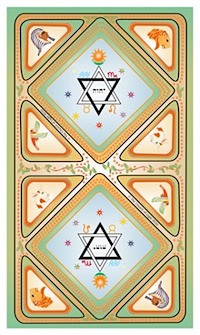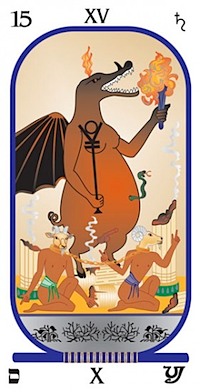By Sheri Harshberger
Brotherhood of Light Egyptian Tarot created by The Church of Light
Published by U.S. Games Systems, Inc.
ISBN: 978-1-57281-656-5
The Brotherhood of Light Egyptian Tarot is a update of the classic black and white deck previously released by The Church of Light. The deck is intended to be used with the book The Sacred Tarot, which is actually a collection of lessons written by C.C. Zain that relate to the use, understanding, and reading of the Tarot within an esoteric context.
Before I go further into my review, I just want to take a moment and thank the publishers like U.S. Games Systems, Llewellyn, Schiffer and others for reprinting some of the popular out of print decks of the past. As someone who discovered Tarot at a later date than when the original release of iconic decks like the Buckland Romani, Sheridan Douglas, Morgan's, and many others such as this one, reprints are the only way we can actually entertain the idea of owning our own copies at prices we can afford. *THANK YOU!*
Now, where was I? Ah, yes... The Brotherhood of Light Egyptian Tarot. As I mentioned previously, the original deck was published in black and white. This new edition, or should I say "reincarnation" was designed by Vicki Brewer. It is in color and is well done. I am sure that there are people who own the black and white version that have seen this one and may still prefer the original. However, I think that we can all agree that this colorized version can stand on its own merits. The imagery is finely detailed and the colors are well chosen. The deck is somewhat smaller than a Waite Smith, but slightly taller than a standard playing card deck, so the 78-card deck is very easily handled. The backs of the cards are beautiful and the deck supports those who read reversals.
While the imagery is beautiful, I find the figures, especially the Majors, a bit stoic. I do like how the Kings and Queens are shown doing different things, relevant to their meanings as opposed to all being seated or doing the same thing with just a bit of scenery and elemental props swapped out from one to the next.
The deck is traditionally structured with 22 numbered Majors and 56 Minors. There are no card titles on any of the cards. Each Majors card includes an Arabic and a corresponding Roman numeral in the border. Also in the border are the corresponding Astrological sign for the card, and the Hebrew and corresponding English letter associated with the card. The Majors of the deck are renamed in most cases in support of the Church of Light system and stacks up against the more recognizable mainstream names as follows (shown in order of number):
Magician = The Magus
High Priestess = Veiled Isis
Empress = Isis Unveiled
Emperor = The Sovereign
The Hierophant (same for both)
Lovers = The Two Paths
Chariot = The Conqueror
Justice = The Balance
Hermit = The Sage
Wheel of Fortune = The Wheel
Strength = The Enchantress
Hanged Man = The Martyr
Death = The Reaper
Temperance = The Alchemist
Devil = The Black Magician
Tower = The Lightning
The Star (same for both)
The Moon (same for both)
The Sun (same for both)
Judgement = The Sarcophagus
World/Universe = The Adept
Fool = The Materialist
Notice that The Balance (Justice) is in the 8th position and The Enchantress (Strength) is in 11th. With regards to the Hebrew letter correspondences, The Materialist (Fool), which is in position 22 (at the end of the Majors rather than the beginning) is associated with Tau. There are some other differences in correspondences when compared to other more ubiquitous methods and decks, but find when working with this deck using this system, it stands well.
The Minors are non-scenic pips, with very busy borders as well. Each card has its rank, Astrological sign, elemental suit and corresponding playing card suit in its border. The Courts are ranked as Kings, Queens, Youths (designated by "J") and Horsemen. The playing card suits of spades, clubs, diamonds and hearts are associated with swords, scepters, coins and cups, respectively.
The deck comes with a 47-page LWB titled How to Use Brotherhood of Light Egyptian Tarot Cards. The front cover is adorned with a schematic of the Silver Key. The contents include an introduction, a discussion of how the cards differ from other decks, short meanings for each of the 78 cards in the deck, how to read the cards for others, and two spreads, the 5-card "Yes/No" Spread and "The Magic Seven Spread" ("Seven" alludes to there are 7 cards in the layout) which is laid in the form of a 6-pointed star. Information on the origin and design of the card backs is also included.
Although I found the Egyptian style imagery a bit stoic, as I said before, I want to be sure to mention that was and am able to read with this deck out of the box using the Tarot knowledge I already have. However, that just scratches the surface, so to get the maximum out of the deck, I highly recommend getting the companion book, The Sacred Tarot by C.C. Zain. Not only will the book add depth to the readings given with this deck, but many of the methods and techniques discussed in the lessons that make up the book will enhance any reader's skill set using any deck or oracle. I can't recommend it enough.



